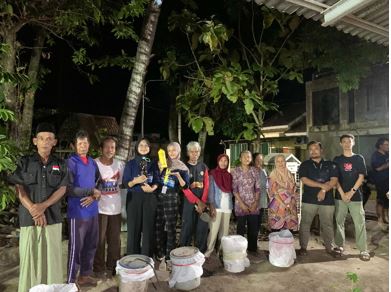
The UGM KKN team conducted an educational session and practical workshop on making a liquid organic fertilizer (POC) in Cangkring Hamlet, Bantul Regency, Yogyakarta Special Region.
POC is a fertilizer produced naturally through fermentation, resulting in a decomposition solution from goat manure.
Coordinating with the local hamlet administration, the KKN-PPM students invited five representatives from each RT (neighborhood unit) and the Women Farmers Group (KWT) as representatives of farmers and goat ranchers to make the fertilizer together.
By involving the farmers and ranchers, the finished POC is expected to be directly applied to the farmers’ fields.
Titis Putri Dika Amalia, a student from the UGM Faculty of Veterinary Medicine (FKH UGM), explained to reporters on Tuesday (Jul. 30) that many goat ranchers in Cangkring Hamlet have not yet utilized goat manure as a potential product like POC.
She noted that POC is a relatively better fertilizer because it avoids chemical or synthetic ingredients.
She explained, “This fertilizer is safer for health than chemical fertilizers and makes the soil more fertile.”
Furthermore, Amalia mentioned that POC has the advantage of addressing nutrient deficiencies and supplying nutrients quickly, thereby improving plant nutrition.
Aliyya Hastuti, another KKN student, added that the introduction to POC was done through educational sessions explaining the definition, benefits, and process of making POC. She noted that the residents, mostly farmers and ranchers, were enthusiastic about the workshop.
“We invited the residents to practice making the fertilizer directly,” Hastuti said.
The making of POC involves several tools and materials, such as goat manure, EM4, molasses, wood ash, a bucket, a sack, and water.
The process begins by mixing the goat manure and wood ash, then placing the mixture into a sack and tying it. Next, a salt solution is poured into a bucket, and the sack of goat manure is added.
Then, a mixture of molasses and water is added to the bucket, followed by EM4. The fermentation process takes place anaerobically for 1-2 weeks.
Once fermented, the nutrient concentration in the POC is measured using a TDS meter, which can be applied to the residents’ crops.
Hastuti expressed hope that through this educational and practical program, the residents of Cangkring Hamlet would pass on their knowledge to others.
“We hope this program will enhance the farmers’ and ranchers’ understanding of the innovation of using goat manure to produce liquid organic fertilizer, thereby improving the growth and productivity of their crops,” she concluded.
Author: Agung Nugroho
Editor: Gusti Grehenson

